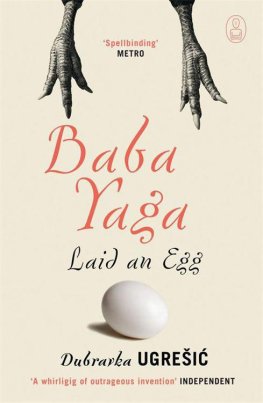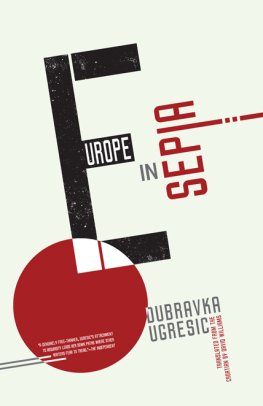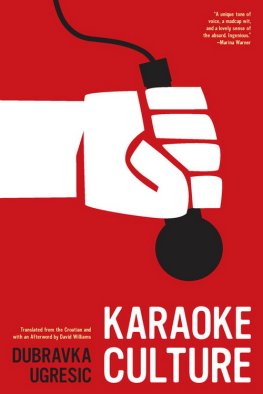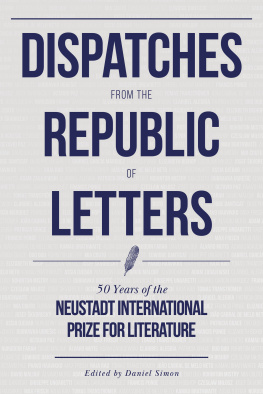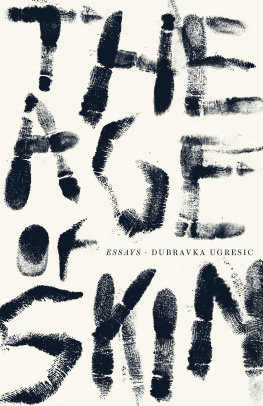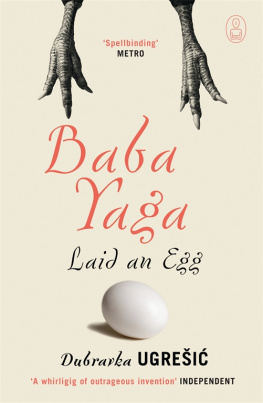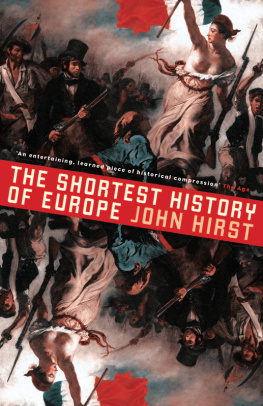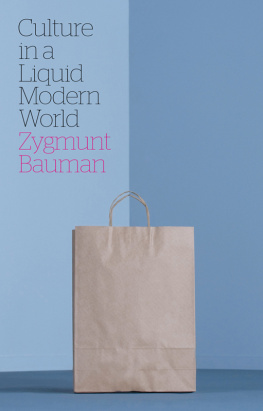PRAISE FOR DUBRAVKA UGRESIC
Ugresic, a game and inquisitive critic, looks at culture from all angles, which sometimes means picking up the mic.... Karaoke Culture is an essential investigation of our times.
Los Angeles Times
Ugresic must be numbered among what Jacques Maritain called the dreamers of the true; she draws us into the dream.
New York Times
[Karaoke Culture is] a brilliant collection of timely essays.
Publishers Weekly (starred review)
Dubravka Ugresic is the philosopher of evil and exile, and the storyteller of many shattered lives.
Charles Simic
A unique tone of voice, a madcap wit and a lively sense of the absurd. Ingenious.
Marina Warner
ALSO BY DUBRAVKA UGRESIC
ESSAYS
The Culture of Lies: Antipolitical Essays
Have a Nice Day: From the Balkan War to the American Dream
Karaoke Culture
Nobodys Home
Thank You for Not Reading: Essays on Literary Trivia
FICTION
Baba Yaga Laid an Egg
Fording the Stream of Consciousness
In the Jaws of Life and Other Stories
Lend Me Your Character
The Ministry of Pain
The Museum of Unconditional Surrender

Copyright 2013 by Dubravka Ugrei
Translation copyright 2014 David Williams
Originally published in Croatian as Europa u sepiji (Beograd: Fabrika knjiga 2013)
First edition, 2014
All rights reserved
All citations of Envy by Yuri Olesha are taken from Marian Schwartzs 2004 translation, published by New York Review Books.
Essays from this collection previously appeared in the following: Fatal Attraction, Liquid Times, Jumping off the Bridge, A Mouthful, and Soul for Rent! appeared together under the title My Own Little Mission in The Baffler; The Code, The Dream of Dorian Grey, A Middle Finger, and Who Is Timmy Monster? appeared together as The Code in The Baffler; Wittgensteins Steps appeared as Wittgensteins Steps: A Letter from Unified Europe in The Baffler; an abridged version of ON-zone appeared as Out of Nation Zone in Salmagundi; Europe in Sepia and Mice Shadows appeared in Salmagundi; A Croatian Fairy appeared in The White Review; an abridged version of Can a Book Save our Life? appeared in Bookforum; and an abridged version of Zagreb Zoo appeared in PEN Atlas.
Library of Congress Cataloging-in-Publication Data: Available upon request.
ISBN-13: 978-1-934824-90-0
Text set in Caslon, a family of serif typefaces based on the designs of William Caslon (16921766).
Design by N. J. Furl
Open Letter is the University of Rochesters nonprofit, literary translation press: Lattimore Hall 411, Box 270082, Rochester, NY 14627
www.openletterbooks.org
CONTENTS
We are a breed of men that has reached its upper limit, he would say, banging his mug on the marble like a hoof.
Yuri Olesha, Envy
NEW YORK, ZUCCOTTI PARK
I visited New York in October 2011, and a couple of days after arriving, I set off for Wall Street, not having checked the exact location of Zuccotti Park. Coming out of the subway, I fortunately spotted an information kiosk.
Excuse me, wheres the, ah... revolution? I asked goofily.
Just go straight on, its a few blocks away, replied a young guy, his face spreading into a smile. Buoyed by the smile, I got going. As the rhythm of my pulse quickened, I wondered whether a long dormant rebel virus was stirring in me. Rebel?! Well, yeah, when you line up a few historical and personal details, its fair to say that rebellion and I are well acquainted.
My parents conceived me around the time when Tito said his famous NO to Stalin. I came into the world in 1949, when the Soviet Union and its fraternity of member states had recently accused Yugoslavia of deviating from the path of Marxism and Leninism. The same Brave Danko tears his heart from his chest, lighting the way for a cowering crowd trapped in a deep, dark forest, and leads them into a sunny clearing. Danko ends up dead, of course, alone and abandoned, what else. The part where some imbecile, having just crawled out of the darkness and into the light, steps on Dankos still beating heart took root in my imagination forever. An unproductive affinity for dreamers who use their hearts as batteries has followed me unfailingly ever since.
By the time I got to grade school, together with my classmates I sent letters of support to Patrice Lumumba, imprisoned somewhere in distant Congo. As a girl I pronounced the names Jawaharlal Nehru, Gamal Abdel Nasser, Kwame Nkrumah, and Sirimavo Bandaranaike, leaders of the Non-Aligned Movement, with the same ease that todays kids pronounce Rubeus Hagrid, Albus Dumbledore, and Alastor Mad-Eye Moody. Theres no mystery in it; I was twelve when the Non-Aligned Movement held its first conference in Belgrade. I protested against the war in Vietnam, even though I wasnt a hundred percent sure where Vietnam was. I spent my childhood sincere in the belief that everyone in the worldblack, yellow, white, whateverhad the right to freedom and equality.
On the approach to Zuccotti Park I spent a moment checking my pulse. I wondered whether the slogan Power to the workers, peasants and honest intelligentsia hadnt done a number on me, and in this respect, whether my compatriots, those who twenty years ago accused me of being Yugonostalgic, might have had it right after all. At the time I publically opposed the hysteria of nationalism, when I should have realized that nationalism is a matter of profit, not feeling. I opposed the war, when I should have accepted the thesis that war is just business, a way to make money by other means. My compatriots cottoned on to these things from the outset, and unperturbed, ran roughshod over the top of me, reenacting what the aforementioned imbecile from my picture book did to Dankos beating heart. Drawing near to Zuccotti Park, I wondered whether that old revolutionary fervor had been hibernating in me, lying in wait for its chance to come out, now, at the wrong time, and in a place I would have least suspected.
YUGONOSTALGIA
I found myself back in America having accepted a kind invitation from Oberlin College in Ohio, where they had organized a lecture series entitled Remembering Communism: The Poetics and Politics of Nostalgia. The Oberlin invitation momentarily boosted my tattered, veterans self-confidence. It quickly atrophied. After twenty years of digging through the ruins, what more could I say about nostalgia, except from that, for me, it has long since lost its draw. The thought of getting down to work induced only fatigue. An insuperable mass of written and as-yet-unwritten texts swelled before me, my own and those of others. Then came the books, films, images, stories, memoirs, symbols and souvenirs, enough to fill an enormous storeroom, a chaotic archive in which all manner of things had settled: seminal theoretical texts such as Svetlana Boyms
Next page

